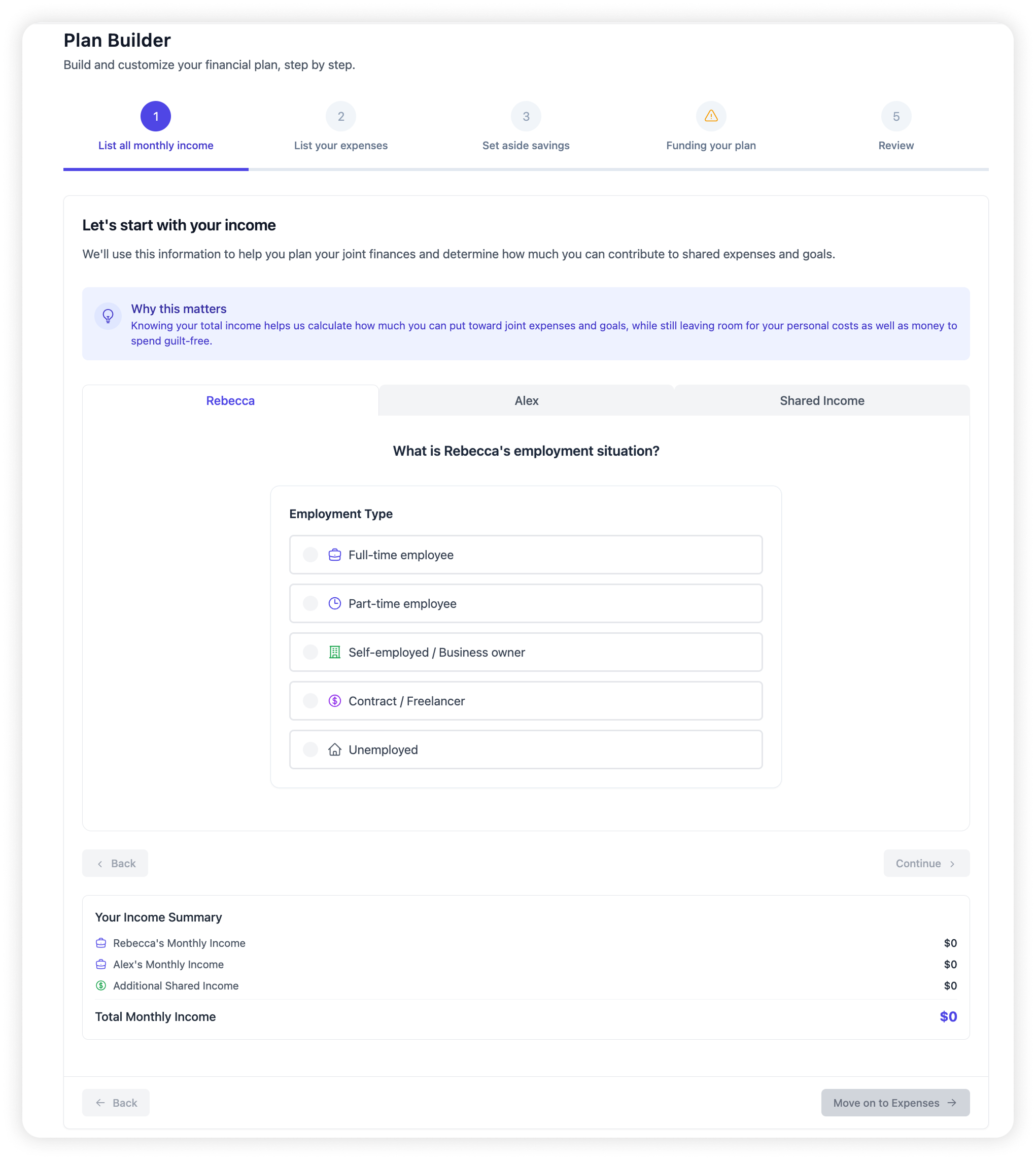June 17, 2025
Use code TOGETHER50 for 50% off your first year — Ends 12/31/25*
Start your financial journey together with 50% off your first year. Use code TOGETHER50 — Ends 12/31/25*
How Couples Can Manage Money Together
Discover why the hybrid 'Pay-In' model, built around the idea of 'Yours, Mine, and Ours', is a smart and flexible way for couples to share expenses without fully merging their finances.

You’ve moved in together. You split the rent, maybe alternate on groceries, and somehow Venmo has become a third wheel in your relationship.
At some point, most couples hit the “ok, we need a better system” moment when your relationship feels fully shared, but your finances are still disconnected.
That’s when the questions start:
Should we open a joint account? Should we merge everything? What’s fair if one person makes more? How do we make this less awkward? And how do we do this without losing our independence or our minds?
What Is the Best Way for Couples to Manage Their Finances?
When it comes to managing money together, couples often feel stuck between two traditional extremes:
- Keep everything separate. This can protect independence, but often leads to complicated tracking, spreadsheet headaches, uneven contributions, and a “roommates with receipts” dynamic.
- Merge everything. This may seem simpler, but it can cause resentment if spending styles clash or if income levels differ significantly. It also creates awkward dynamics. No one wants to feel like they have to ask permission to spend their own hard-earned money. And when everything is pooled, your individual financial identity can start to feel like it’s disappearing—or even becoming non-existent—which adds another layer of tension to already delicate conversations.
Neither approach fully meets the needs of modern couples managing money together for the first time. That’s where a hybrid model for couples’ finances really shines.
The “Pay-In” Hybrid Model: Shared Goals, Separate Space
.png)
The “Pay-In” model is simple:
Each partner maintains their own account, but each month contributes to a shared pot to cover joint expenses and household budgeting. This includes things like rent, groceries, subscriptions, and future travel plans. After “funding” your joint plan what’s left over is free for you to spend how you want.
Why It Works (Especially Early On)
- You stay connected without giving up control. You’re aligned on shared goals, but still have individual autonomy over your personal accounts.
- It adapts to changing life stages. Whether you’re moving in, getting married, or starting a family, the hybrid approach can scale with you.
- It feels fair. Contributions can be equal or proportionate to income (we recommend proportional based on take-home pay). It’s up to you and it’s easy to adjust over time.
- It reduces resentment. Your plan gives you room to spend freely, without guilt. As long as you’re both putting in your fair share, you don’t have to answer for every latte or impulse buy.
- It’s easy to start. This popular hybrid model is especially great for couples just starting out because you don’t need to change anything about how you each currently get paid.
Meet Alex and Jamie: A Quick Example
Alex and Jamie just got married and want to manage their finances in a more coordinated way. Jamie takes home $5,800/month, and Alex takes home $4,200/month after taxes.
They decide to cover $3,000/month in shared expenses (rent, groceries, and household bills) and also contribute $1,000/month toward a shared goal (saving for a future home).
That brings their shared monthly budget to $4,000 which includes both day-to-day expenses and joint savings goals.
To keep things fair, they split contributions proportionally based on take-home pay.
- Together, they take home $10,000/month.
- Jamie brings in 58%, so contributes $2,320/month.
- Alex brings in 42%, so contributes $1,680/month.
.png)
The rest of their income stays in their personal accounts for individual savings, hobbies, or anything else. That’s the beauty of this couples budgeting and planning strategy. You’re totally aligned, but also not fully merged. As long as each person is contributing their fair share and holding up their end of the plan the leftover money can be used guilt-free.
It’s not rigid, it’s respectful.
Each month they check in on shared spending, adjust contributions if needed, and talk about what’s ahead. If they want to boost their savings rate (like wanting to buy a house sooner than later), they’ll update the plan together, knowing it means a little less personal wiggle room for both of them.
With the Pay-In plan, you have a system for transparently adjusting your monthly contributions as your needs and incomes evolve. Over time, you might decide to shift more expenses from the personal side to the shared side or increase your joint savings to hit a big goal faster. Your plan grows with you, adapting to each new phase of your relationship.
Start Where You Are
You don’t have to merge everything to feel like a team. In fact, the best partnerships often start by honoring both the individual and the shared.
The hybrid pay-in model isn’t just a stopgap, it’s a sustainable foundation for managing money together as a couple while building trust, clarity, and momentum.
But like any system, it comes with trade-offs: it takes some upfront coordination to set up, ongoing check-ins to keep it fair, and without the right tools, it’s hard to see your full financial picture. Many couples end up tracking accounts manually in a spreadsheet only to find it’s already out of date by the time they sit down to review it.
That’s where JoyFi helps couples manage joint finances more easily. No spreadsheets required.
JoyFi is pioneering a new approach we call Collaborative Personal Finance. It’s designed for couples who want to work as a team while still maintaining some independence. With JoyFi, you can easily set up, configure, and adjust your Pay-In plan. Our flexible account permissioning model lets you assign linked bank accounts as yours, mine, and ours while keeping your full joint net worth up to date in one shared view.
The best collaborative finance strategy blends total transparency with personal freedom.
Ready to give it a try?
Start small. Set a shared goal. Agree on what goes in the pot. And watch how it strengthens your partnership without sacrificing your independence.
Onwards, together.
Set up your Pay-In plan
Try JoyFi for free



